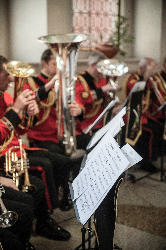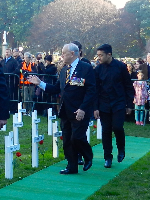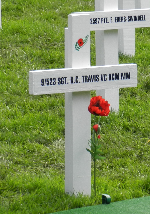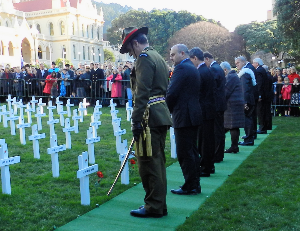Guide for White Cross Ceremonies
Field of Remembrance Ceremony
| It is appropriate to mark the establishment of a field of white crosses with a ceremony. We recommend that your Field be laid out prior to any ceremony although you may wish to ceremonially lay one last cross e,g, that of the soldier “Known only to God”. You may wish to invite the New Zealand Defence Force to help set up your field or involve them in any commemoration or events around Anzac Day. The Royal New Zealand Returned and Services Association have developed a DIY tool-kit to deliver commemorative ceremonies. The toolkit includes protocols, a suggested order of service and sound files. Please click here to access RNZRSA Toolkit. |
Field of Remembrance Ceremony at Parliament Grounds.
|
Your commemoration can be made special by your choice of music, poetry and story. Here are some additional resources to help personalize your commemoration:
Music |
Click on the title to link to music and lyrics:
|
| Poetry There are many enduring and compassionate poems from the First World War – one the best know is: In Flanders Field by John McCrae, May 1915 There will be a poem or a verse that resonates with pupils whether by Siegfried Sassoon, Wilfred Owen or one of the Anzac soldiers. You can find examples on these websites: First World War Poetry Or pupils may wish to write their own poetry for the occasion. Stories From your research there may be a story of particular importance for your pupils. This could be integrated into your ceremony. It may be the story of one of Fallen from your Field or School; or it could be memories of a soldier who returned to your community. |
In Flanders Fields In Flanders fields the poppies blow Between the crosses, row on row, That mark our place; and in the sky The larks, still bravely singing, fly Scarce heard amid the guns below. We are the Dead. Short days ago We lived, felt dawn, saw sunset glow, Loved and were loved, and now we lie In Flanders fields. Take up our quarrel with the foe: To you from failing hands we throw The torch; be yours to hold it high. If ye break faith with us who die We shall not sleep, though poppies grow In Flanders fields. |
  |
Other options:
Although the cross is a Christian symbol the origins of crosses on soldier’s graves dates back to Medieval times. A fallen Knight’s sword would be thrust into the ground to mark his grave. Even in recent times a soldier’s rifle could be used to mark his final resting place. |
 Login
Login

